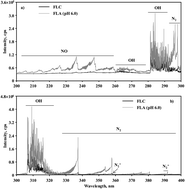当前位置:
X-MOL 学术
›
J. Anal. At. Spectrom.
›
论文详情
Our official English website, www.x-mol.net, welcomes your
feedback! (Note: you will need to create a separate account there.)
Influence of pH and low-molecular weight organic compounds in solution on selected spectroscopic and analytical parameters of flowing liquid anode atmospheric pressure glow discharge (FLA-APGD) for the optical emission spectrometric (OES) determination of Ag, Cd, and Pb
Journal of Analytical Atomic Spectrometry ( IF 3.1 ) Pub Date : 2018-01-30 00:00:00 , DOI: 10.1039/c7ja00374a Krzysztof Swiderski 1, 2, 3, 4, 5 , Anna Dzimitrowicz 1, 2, 3, 4, 5 , Piotr Jamroz 1, 2, 3, 4, 5 , Pawel Pohl 1, 2, 3, 4, 5
Journal of Analytical Atomic Spectrometry ( IF 3.1 ) Pub Date : 2018-01-30 00:00:00 , DOI: 10.1039/c7ja00374a Krzysztof Swiderski 1, 2, 3, 4, 5 , Anna Dzimitrowicz 1, 2, 3, 4, 5 , Piotr Jamroz 1, 2, 3, 4, 5 , Pawel Pohl 1, 2, 3, 4, 5
Affiliation

|
Atmospheric pressure glow discharge operated in contact with a flowing liquid anode (FLA-APGD), with the solution pH adjusted to pH 6.0 or pH 1.0, was performed to elucidate plasma-chemical processes and reactions occurring in the discharge and the liquid phase. The morphologies in the emission spectra of both FLA-APGD systems in reference to molecular (NO, OH, N2, and N2+) and atomic (H and O) excited species in addition to selected spectroscopic parameters, including the rotational, vibrational, and excitation temperatures and electron number density, were assessed for both discharge systems and compared with those evaluated for APGD operated in contact with a flowing liquid cathode (FLC-APGD). The effect of low-molecular weight (LMW) alcohols (methanol and ethanol) and carboxylic acids (formic acid and acetic acid) added to the FLA solution on the morphology of the spectra and spectroscopic parameters of both discharge systems was studied as well. The analytical performance of both FLA-APGD systems, compliant with the intensities of the atomic lines of Ag, Cd, and Pb, the signal-to-background ratios of these lines, and the detection limits of Ag, Cd, and Pb, under conditions of the absence and presence of the aforementioned LMW organic compounds was determined and compared. It was established that APGD operated in contact with FLA solutions acidified to pH 1.0 or buffered to pH 6.0 conferred a unique set of advantages as compared to the case of the FLC-APGD system. Both FLA-APGD systems were characterized by a large population of high energy electrons and molecular and atomic excited states not quenched by H2O vapor, as in the case of FLC-APGD. Particularly, for the FLA-APGD (pH 1.0) system, the addition of LMW organic compounds resulted in an improvement in its analytical performance for the detection and determination of Ag, Cd, and Pb.
中文翻译:

pH和溶液中的低分子量有机化合物对液体阳极大气压辉光放电(FLA-APGD)的选择光谱和分析参数的影响,用于光发射光谱法(OES)测定Ag,Cd和Pb
进行大气压辉光放电,使其与流动的液体阳极(FLA-APGD)接触,溶液的pH值调整为pH 6.0或pH 1.0,以阐明在放电和液相中发生的等离子体化学过程和反应。两个FLA-APGD系统的发射光谱中涉及分子(NO,OH,N 2和N 2 +的形态))评估了两个放电系统的原子和分子(H和O)激发物种以及选定的光谱参数,包括旋转,振动和激发温度以及电子数密度,并与在与流动相接触的条件下操作的APGD进行了比较液体阴极(FLC-APGD)。还研究了添加到FLA溶液中的低分子量(LMW)醇(甲醇和乙醇)和羧酸(甲酸和乙酸)对两个放电系统的光谱形态和光谱参数的影响。这两种FLA-APGD系统的分析性能均符合Ag,Cd和Pb原子线的强度,这些线的信噪比以及Ag,Cd和Pb的检出限,在不存在和存在上述LMW有机化合物的条件下,测定并比较。已经确定,与FLC-APGD系统相比,APGD与酸化至pH 1.0或缓冲至pH 6.0的FLA溶液接触可提供独特的优势。两种FLA-APGD系统均具有大量高能电子以及未被H淬灭的分子和原子激发态与FLC-APGD一样,为2 O蒸气。特别是,对于FLA-APGD(pH 1.0)系统,添加LMW有机化合物导致其检测和测定Ag,Cd和Pb的分析性能得到改善。
更新日期:2018-01-30
中文翻译:

pH和溶液中的低分子量有机化合物对液体阳极大气压辉光放电(FLA-APGD)的选择光谱和分析参数的影响,用于光发射光谱法(OES)测定Ag,Cd和Pb
进行大气压辉光放电,使其与流动的液体阳极(FLA-APGD)接触,溶液的pH值调整为pH 6.0或pH 1.0,以阐明在放电和液相中发生的等离子体化学过程和反应。两个FLA-APGD系统的发射光谱中涉及分子(NO,OH,N 2和N 2 +的形态))评估了两个放电系统的原子和分子(H和O)激发物种以及选定的光谱参数,包括旋转,振动和激发温度以及电子数密度,并与在与流动相接触的条件下操作的APGD进行了比较液体阴极(FLC-APGD)。还研究了添加到FLA溶液中的低分子量(LMW)醇(甲醇和乙醇)和羧酸(甲酸和乙酸)对两个放电系统的光谱形态和光谱参数的影响。这两种FLA-APGD系统的分析性能均符合Ag,Cd和Pb原子线的强度,这些线的信噪比以及Ag,Cd和Pb的检出限,在不存在和存在上述LMW有机化合物的条件下,测定并比较。已经确定,与FLC-APGD系统相比,APGD与酸化至pH 1.0或缓冲至pH 6.0的FLA溶液接触可提供独特的优势。两种FLA-APGD系统均具有大量高能电子以及未被H淬灭的分子和原子激发态与FLC-APGD一样,为2 O蒸气。特别是,对于FLA-APGD(pH 1.0)系统,添加LMW有机化合物导致其检测和测定Ag,Cd和Pb的分析性能得到改善。











































 京公网安备 11010802027423号
京公网安备 11010802027423号